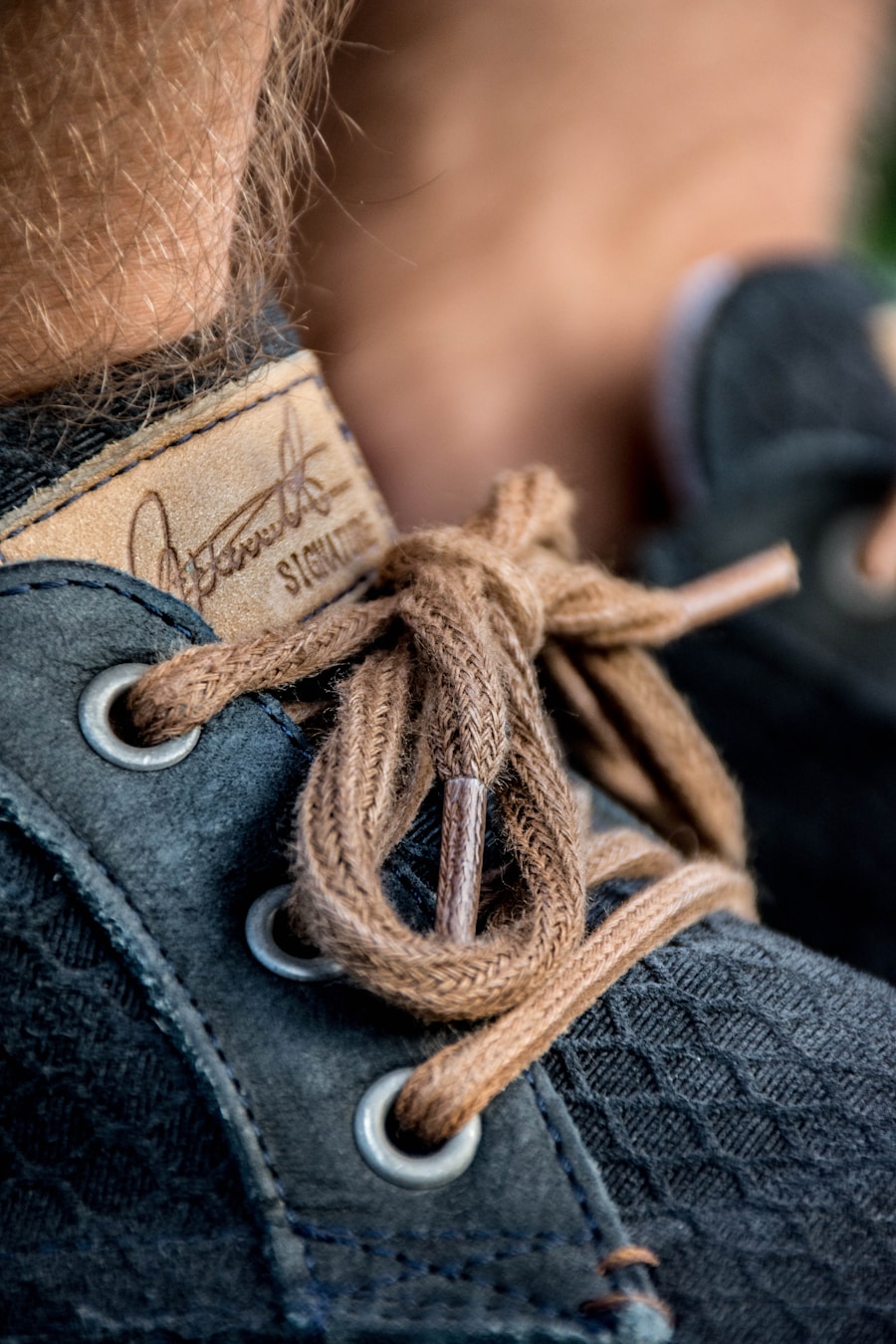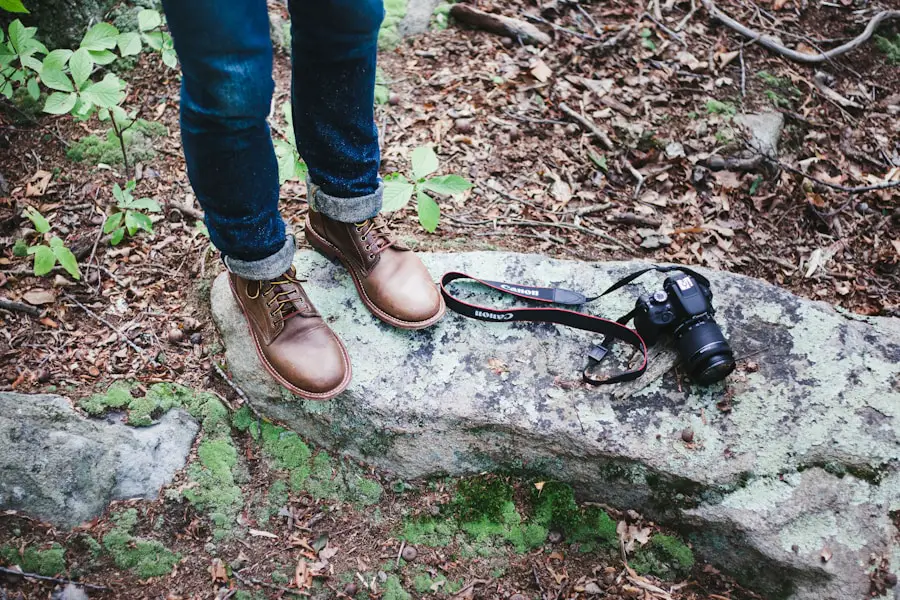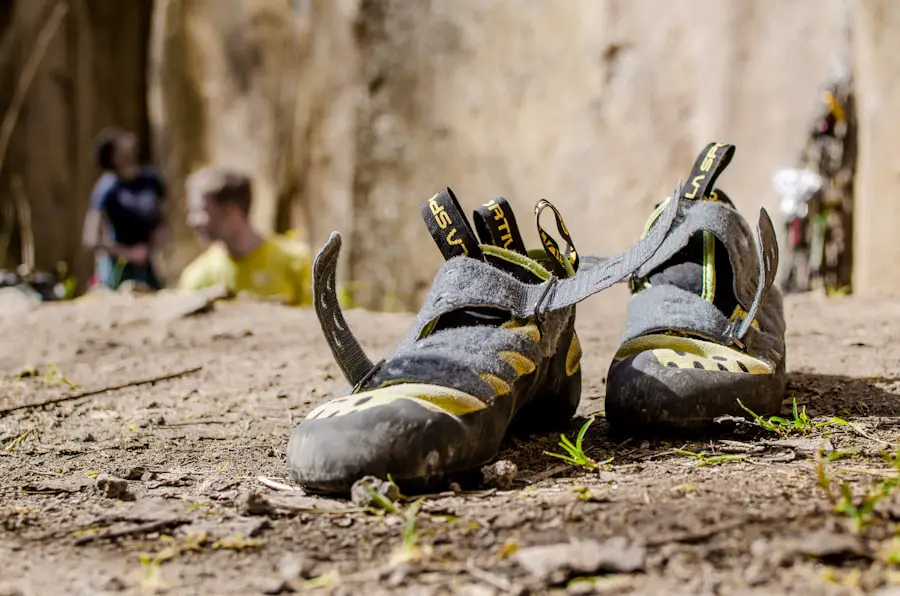Properly tying hiking boots is a fundamental aspect of outdoor activities that is often overlooked by both novice and experienced hikers. The way boots are laced can significantly impact comfort, stability, and overall performance on the trail. When hiking, the feet endure various stresses, including uneven terrain, steep inclines, and prolonged periods of activity.
A secure fit helps to minimize foot movement within the boot, reducing the risk of blisters and enhancing overall foot health. Moreover, a well-tied boot can improve balance and control, which is crucial when navigating rocky paths or slippery surfaces. In addition to comfort and stability, properly lacing hiking boots can also enhance safety.
Loose or improperly tied laces can lead to accidents, such as tripping or rolling an ankle. When boots are laced correctly, they provide the necessary support to the ankle, which is particularly important when traversing challenging landscapes. Furthermore, a snug fit can help prevent fatigue by ensuring that the foot is well-supported throughout the hike.
Therefore, understanding the importance of tying hiking boots correctly is essential for anyone looking to enjoy their outdoor adventures safely and comfortably.
Key Takeaways
- Properly tying hiking boots is crucial for a secure and comfortable fit, as well as preventing blisters and hot spots.
- Different lacing techniques can be used to customize the fit of hiking boots to individual foot shapes and preferences.
- Achieving a secure and comfortable fit involves proper tension and distribution of pressure across the foot.
- Prevent blisters and hot spots by adjusting lacing techniques to reduce friction and pressure points.
- Adjust lacing for different terrains and conditions to optimize support, stability, and comfort during hiking.
Understanding Different Lacing Techniques for Hiking Boots
There are several lacing techniques that hikers can employ to achieve a secure fit tailored to their specific needs. The most common method is the standard crisscross lacing, where the laces are threaded through the eyelets in a crisscross pattern from the bottom to the top of the boot. This technique provides a balanced fit and is suitable for most hiking conditions.
However, for those who require additional support or have specific foot shapes, alternative lacing methods can be beneficial. One such technique is the heel lock lacing method, which is particularly useful for preventing heel lift during descents. This method involves creating a loop with the laces at the top eyelets and threading the lace back through this loop before tying it off.
This creates a tighter fit around the heel, reducing movement and enhancing stability. Another technique is the skip lacing method, where certain eyelets are skipped to relieve pressure on specific areas of the foot. This can be particularly helpful for hikers with high arches or those who experience discomfort in certain spots.
Understanding these various techniques allows hikers to customize their boot fit according to their unique foot anatomy and hiking conditions.
Tips for Achieving a Secure and Comfortable Fit

Achieving a secure and comfortable fit in hiking boots requires attention to detail and an understanding of individual foot characteristics. One of the first steps is to ensure that the boots are the correct size. Hiking boots should fit snugly but not painfully tight; there should be enough room in the toe box to wiggle your toes without feeling cramped.
When trying on boots, it’s advisable to wear the same type of socks that will be used during hikes, as this can affect fit. Additionally, trying on boots later in the day when feet are slightly swollen can help ensure a more accurate fit. Once the right size is determined, it’s essential to focus on how the boots are laced.
Starting from the bottom, laces should be pulled evenly to avoid creating pressure points. As you lace up, pay attention to how the boot feels around your ankle and instep; adjustments may be necessary as you move up the boot. It’s also beneficial to experiment with different lacing techniques to find what works best for your foot shape and hiking style.
For instance, if you notice that your foot slides forward during descents, consider using a heel lock technique for added security. Ultimately, achieving a secure and comfortable fit is about finding the right balance between snugness and flexibility.
How to Prevent Blisters and Hot Spots with Proper Lacing
| Lacing Technique | Effectiveness |
|---|---|
| Parallel Lacing | Reduces friction and prevents heel slippage |
| Heel Lock Lacing | Secures the heel and prevents blisters on the back of the foot |
| Window Lacing | Relieves pressure on the top of the foot and prevents hot spots |
| Toe Reliever Lacing | Prevents toe blisters and discomfort in the toe box |
Blisters and hot spots are common issues faced by hikers, often resulting from friction between the foot and boot.
Proper lacing techniques can play a crucial role in preventing these painful occurrences. One effective strategy is to ensure that the laces are tightened appropriately throughout the entire boot.A loose fit can cause excessive movement of the foot within the boot, leading to friction and potential blister formation. By maintaining consistent tension in the laces, hikers can minimize this movement and reduce the risk of blisters. Another preventive measure involves paying attention to specific areas of concern on your feet.
If you know that certain spots are prone to blisters, such as the heel or sides of the toes, consider adjusting your lacing technique accordingly. For example, using skip lacing in areas where pressure is felt can alleviate discomfort and reduce friction. Additionally, wearing moisture-wicking socks made from synthetic materials can help keep feet dry and reduce blister risk.
Combining proper lacing techniques with appropriate sock choices creates a comprehensive approach to blister prevention that enhances overall hiking comfort.
Adjusting Lacing for Different Terrains and Conditions
The terrain and conditions encountered during a hike can vary significantly, necessitating adjustments in how hiking boots are laced. For instance, when hiking on steep inclines or rocky paths, a tighter fit around the ankle may be required for added support and stability. In such cases, employing techniques like heel lock lacing can help secure the foot in place, preventing slippage that could lead to injury.
Conversely, when traversing flat or well-maintained trails, hikers may prefer a looser fit for increased comfort and flexibility. This allows for better circulation and reduces fatigue over long distances. Additionally, weather conditions can also dictate how boots should be laced; in wet or muddy conditions, ensuring that laces are tightly secured can help prevent debris from entering the boot while providing better traction on slippery surfaces.
By adjusting lacing techniques based on terrain and conditions, hikers can optimize their performance and comfort throughout their journey.
Utilizing Additional Support and Stability Features in Hiking Boots

Modern hiking boots often come equipped with various support and stability features designed to enhance performance on challenging trails. These features include ankle collars, cushioned insoles, and shank plates that provide additional support where it’s needed most. When tying hiking boots, it’s essential to consider how these features interact with lacing techniques to maximize their benefits.
For example, if a boot has a high ankle collar designed for added support, it’s crucial to lace it tightly around the ankle without compromising comfort. This ensures that the collar functions effectively while still allowing for natural movement of the foot. Similarly, if a boot includes a cushioned insole designed for shock absorption, ensuring that it fits snugly within the boot will enhance its effectiveness during hikes on hard surfaces.
By understanding how to utilize these features in conjunction with proper lacing techniques, hikers can significantly improve their overall experience on the trail.
Maintaining and Caring for Laces to Ensure Longevity
Laces are often an overlooked component of hiking gear; however, they play a vital role in ensuring that boots fit securely and comfortably. To maintain their integrity and longevity, it’s essential to care for them properly. Regularly inspecting laces for signs of wear or fraying is crucial; damaged laces should be replaced promptly to avoid potential failures during hikes.
Cleaning laces is another important aspect of maintenance. Dirt and debris can accumulate over time, affecting both performance and appearance. To clean them effectively, remove them from the boots and wash them with mild soap and water; this helps remove grime without damaging the material.
After washing, allow them to air dry completely before re-lacing your boots. Additionally, storing boots with laces untied or loosely tied can help prevent unnecessary tension on the laces when not in use. By taking these simple steps to maintain laces, hikers can ensure that their footwear remains functional and reliable over time.
Troubleshooting Common Lacing Issues and Solutions
Despite best efforts at proper lacing techniques, hikers may still encounter common issues such as loose laces or uneven tension during hikes. One frequent problem is laces coming undone while walking; this can be particularly frustrating on long treks. To combat this issue, consider using a double knot technique when tying your boots; this provides extra security compared to a standard knot.
Another common issue is uneven pressure across different parts of the foot due to improper lacing patterns. If one area feels too tight while another feels loose, it may be necessary to adjust your lacing technique accordingly. Experimenting with skip lacing or adjusting tension at specific eyelets can help create a more balanced fit throughout the boot.
Additionally, if you experience discomfort or pinching at certain points during hikes, reevaluating your sock choice or considering different insoles may also provide relief. By being proactive about troubleshooting these common issues and employing effective solutions, hikers can enhance their overall experience on the trail while minimizing discomfort and potential injuries associated with improper boot fitting.
If you’re planning a hiking trip, it’s important to make sure your gear is in top shape. One essential item to have is a good pair of hiking boots. To ensure they provide the best support and comfort, it’s crucial to know how to tie them properly. Check out this article for tips on how to tie your hiking boots securely before hitting the trails.
Love travel? Join Our Facebook Community For More Tips.
FAQs
What are the benefits of properly tying hiking boots?
Properly tying hiking boots provides better support and stability for your feet and ankles, reducing the risk of injury while hiking on uneven terrain.
What is the best way to tie hiking boots for ankle support?
For ankle support, use the “heel lock” or “lace lock” technique, which involves creating a loop with the laces around the top two eyelets of the boot to secure the heel in place.
How tight should hiking boots be tied?
Hiking boots should be tied snugly to provide support and prevent rubbing or blisters, but not so tight that they restrict blood flow or cause discomfort.
What are some common lacing techniques for hiking boots?
Common lacing techniques for hiking boots include the “heel lock,” “window lacing,” and “straight bar lacing,” each providing different benefits such as heel support, pressure relief, and improved fit.
How often should I re-tie my hiking boots while on a hike?
It’s a good idea to periodically check and re-tie your hiking boots during a hike, especially if you start to feel any discomfort or notice your boots becoming loose.
